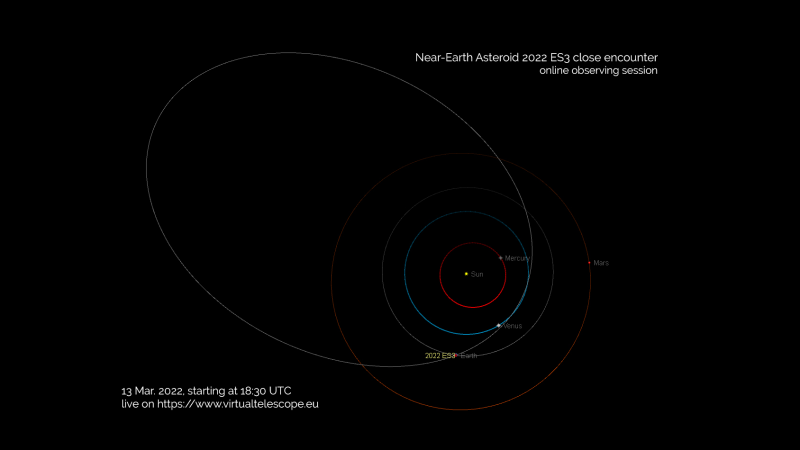Bus-size asteroid flies by Earth today. Watch it live.
See live views of the asteroid via the Virtual Telescope Project.
You can watch a big asteroid make a safe flyby of Earth today (March 13) from any spot with good internet access.
Weather permitting, the Virtual Telescope Project will livestream telescope views of the recently found asteroid 2022 ES3, which will pass by our planet just slightly within the orbit of the moon. The broadcast starts at 2:30 p.m. EDT (1830 GMT) and you can watch it in the video feed above or directly from The Virtual Telescope Project.
Asteroid 2022 ES3 is up to 40 feet wide (12 meters) - about the size of a bus - and will pass within 207,000 miles (330,000 kilometers) of the Earth today, according to NASA. The Kitt Peak National Observatory in Arizona discovered the asteroid on March 7 and, as is typical for near-Earth asteroid finds, published the orbit and other details of the asteroid's movement and size online.
"The Virtual Telescope Project will show it live, online, just at the fly-by time. This way, you can join the journey from the comfort of your home," the project's founder Gianluca Masi wrote in a website statement. He is based in Ceccano, near Rome, Italy.
Related: The greatest asteroid missions of all time!

The asteroid is not considered "potentially hazardous", according to Newsweek, probably due to its size. According to NASA JPL's Small-Body Database, the asteroid has an estimated diameter of 30 to 40 feet (10 to 22 meters).
Masi says the closest the asteroid will approach Earth at a safe distance that is about 87% of the average distance from Earth to the moon. The moon is typically about 238,855 miles (384,400 kilometers) from Earth.
Sign up for the Live Science daily newsletter now
Get the world’s most fascinating discoveries delivered straight to your inbox.
NASA watches for asteroids through partner telescopes and space observations, coordinated through the Planetary Defense Coordination Office. While the agency has found no imminent problems, it does test out asteroid defense technologies to be proactive.
An example is the 1,210-pound (550 kilograms) DART spacecraft, which will slam into a small asteroid named Dimorphos in September or October. The aim is to change the orbit of this asteroid around its larger companion, Didymos.
If you're looking for a telescope or binoculars to spot asteroids like this one, check out our guide for the best binoculars deals and the best telescope deals available now. Our best cameras for astrophotography and best lenses for astrophotography can also help you pick the best imaging gear.
Follow Elizabeth Howell on Twitter @howellspace. Follow us on Twitter @Spacedotcom and on Facebook.

Elizabeth Howell was staff reporter at Space.com between 2022 and 2024 and a regular contributor to Live Science and Space.com between 2012 and 2022. Elizabeth's reporting includes multiple exclusives with the White House, speaking several times with the International Space Station, witnessing five human spaceflight launches on two continents, flying parabolic, working inside a spacesuit, and participating in a simulated Mars mission. Her latest book, "Why Am I Taller?" (ECW Press, 2022) is co-written with astronaut Dave Williams.











